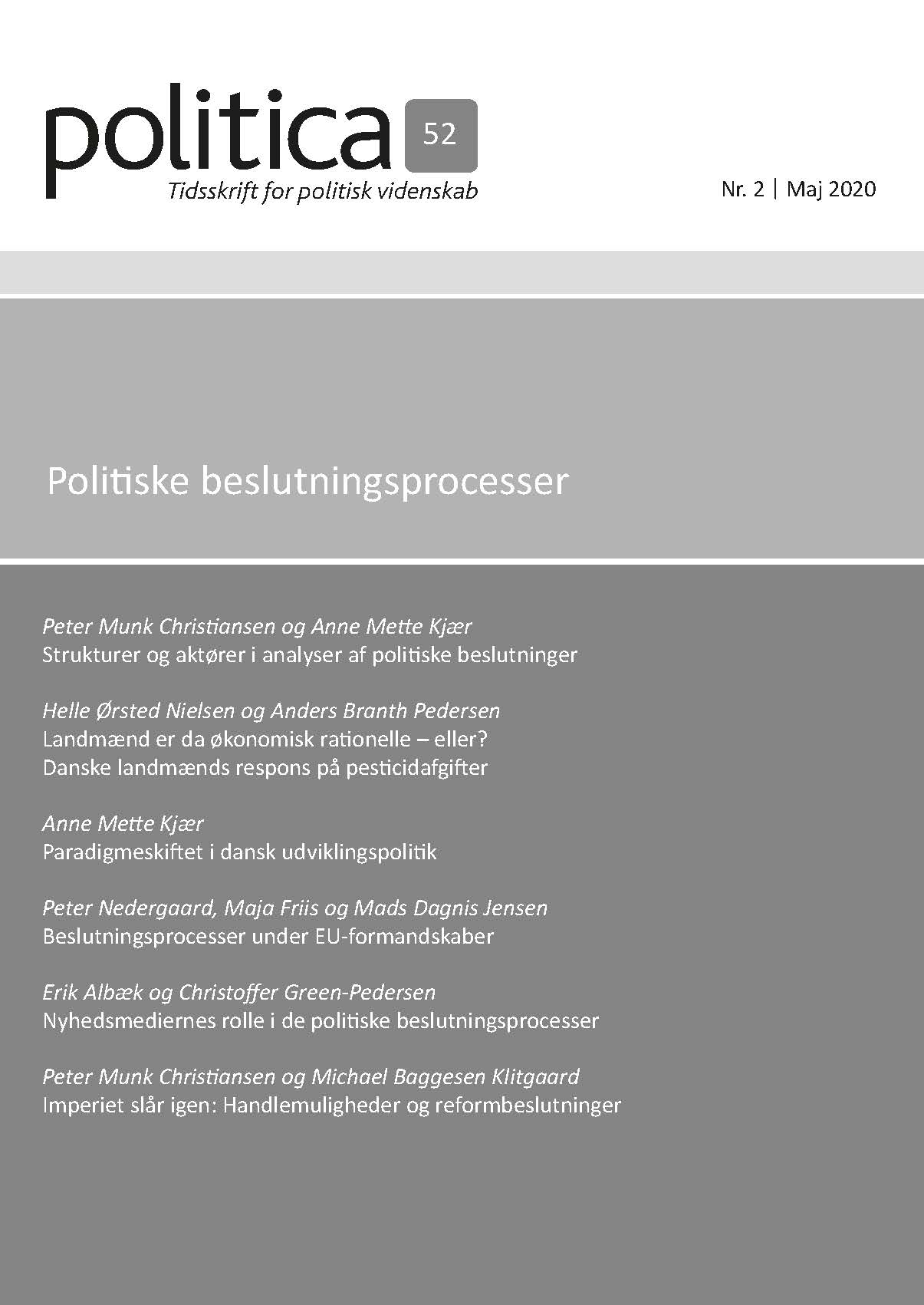Beslutningsprocesser under EU-formandskaber
DOI:
https://doi.org/10.7146/politica.v52i2.130809Keywords:
EU-formandskab, Danmark, Polen, Cypern, trio, dansk EU-formandskabAbstract
Denne artikel analyserer beslutningsprocesserne i centraladministrationerne under varetagelsen af formandskaberne i den Europæiske Union (EU). Gennem et Most Different Systems Design sammenlignes det polske, danske og cypriotiske EU-formandskab i årene 2011-2012, som tilsammen udgjorde en såkaldt Trio. De tre lande adskiller sig politisk, administrativt og geografisk. På trods af disse forskelle og forskelle i politiske reaktionsmønstre kan der også spores betydelige ligheder landene imellem. De viser sig, når man inddrager hele formandskabsprocessen og embedsmændenes meget centrale rolle heri. Med et datagrundlag bestående af interviews med over 80 embedsmænd i alle tre medlemslande dækkende en periode på cirka tre år, påvises det i artiklen, at der er generaliserbar viden om EU-formandskabernes beslutningsprocesser.
References
Coombes, David (1998). The Commission’s relationship with the Presidency. Paper, The Presidency of the European Union Conference, 15.-16. oktober, Belfast, Nordirland.
Corbett, Richard (1998). The Council Presidency as seen from the European Parliament. Paper, The Presidency of the European Union Conference, 15.-16. oktober1998, Belfast, Nordirland.
Council of the European Union (2015). Handbook of the Presidency of the Council of the European Union. Department of the General Secretariat of the Council. https://www.eesistumine.ee/sites/el_veeb/files/presidency_handbook_en.pdf (23. oktober 2017).
Cypriot Ministry of Foreign Affairs (2013). Evaluation of the Cypriot Presidency 2012. Oversat fra græsk: Telikos Apoliyopos Kupriakris Proedrias Sumbouliou EE, Nicosia.
Cyprus Presidency of the Council of the European Union (2012). Programme and Priorities, Government of Cyprus. http://www.cy2012.eu/en/Footer/the-cyprus-presidency/programme-and-priorities (1. august 2015).
Elgström, Ole (red.) (2003). European Union Council Presidencies: A Comparative Perspective. London: Routledge.
Galbraith, Jay R. (1977). Organization Design. Boston: Addison-Wesley Pub. Co.
Gallagher, Michael, Michael Laver og Peter Mair (2011). Representative Government in Modern Europe. 5. udg. Berkshire: McGraw-Hill Education.
George, Alexander L. og Andrew Bennett (2005). Case Studies and Theory Development in the Social Sciences. Cambridge: The MIT Press.
Hayes-Renshaw, Fiona og Helen Wallace (2005). The Council of Ministers. Basinstoke: Palgrave MacMillan.
Jensen, Mads D. og Peter Nedergaard (2013). Det danske EU-formandskab 2012 – satte det sig spor i centraladministrationen? Politica 45(4): 379-399.
Jensen, Mads D. og Peter Nedergaard (2014). Uno, duo, trio? Varieties of Trio Presidencies in the Council of Ministers. Journal of Common Market Studies 52 (5): 1035-1052.
Jensen, Mads D. og Peter Nedergaard (2017). EU Presidencies between Politics and Administration: The Governmentality of the Polish, Danish and Cypriot Trio Presidency. Routledge.
Kaczyński, Piotr M. (2011). Polish Council Presidency 2011: Ambitions and Limitations. Stockholm: Swedish Institute for European Policy Studies, SIEPS.
Karolewski, Ireneusz P., Thomas Mehlhausen og Monika Sus (2015). The Polish EU Council Presidency in 2011: Master or servant? Journal of European Integration 37 (6): 667-684.
Kirchner, Emil (1992). Decision-Making in the European Community: The Council Presidency and European Integration. Manchester: Manchester University Press.
March, James G. og Johan P. Olsen (1989). Rediscovering Institutions. London: Collier Macmillan Publishers.
Nedergaard, Peter og Holly Snaith (2015). ‘As I drifted on a river i could not control’: The unintended ordoliberal consequences of the Eurozone crisis. Journal of Common Market Studies 53 (5): 1094-1109.
Neligan, David (1998). Organizing the Presidency: The Council Perspective. Paper, The Presidency of the European Union Conference, 15.-16. oktober, Belfast, Nordirland.
Passas, Argyris G. og Evangelica I. Katakalou (2012). The Cyprus EU Presidency. “Riders on the Storm.” Stockholm: Swedish Institute for European Policy Studies, SIEPS.
Pierson, Paul (2000). Increasing returns, path dependence, and the study of politics. American Political Science Review 94 (1): 252-267.
Polish Presidency of the Council of the European Union (2012). Final Report: Preparations, Achievements, Conclusions. Forberedt af the Ministry of Foreign Affairs Republic of Poland. http://www.mf.gov.pl/en/documents/764034/1137013/Report_Polish_presidency.pdf (27. februar 2016).
Pomorska, Karoline og Sophie Vanhoonacker (2012). Poland in the driving seat: A mature presidency in turbulent times. Journal of Common Market Studies 50 (1): 76-84.
Seawright, Jason og John Gerring (2008). Case selection techniques in case study research: A menu of qualitative and quantitative options. Political Research Quarterly 61 (2): 294-308.
Steinmo, Sven, Kathleen Thelen og Frank Longstreth (red.) (1992). Structuring Politics. Historical Institutionalism in Comparative Analysis. Cambridge: Cambridge University Press.
Tallberg, Jonas (2004). The power of the presidency: Brokerage, efficiency and distribution in EU negotiations. Journal of Common Market Studies 42 (5): 999-1022.
Tallberg, Jonas (2006). Leadership and Negotiation in the European Union. Cambridge: Cambridge University Press.
Warntjen, Andreas (2008). The Council Presidency: Power broker or burden? An empirical analysis. European Union Politics 9 (3): 315-338.





